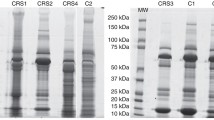Abstract
Otitis media with effusion (OME) is an inflammatory disease of the middle ear cavity that is associated with middle ear effusions (MEEs), which are frequently mucous and serous for pediatric and adult patients exhibiting low and high responsiveness to medical treatment, respectively. To assess the pathological outcomes in mucous and serous MEEs, their protein compositions were determined by sodium dodecyl sulfate-polyacrylamide gel electrophoresis and Western blotting in comparison with those in the same patients’ sera. A mucin, which is immunochemically identical with nasal mucin, was a characteristic consituent of mucous MEEs (n = 25), being present at the concentration of 59.4 mg/ml and comprising about 60% of the total proteins, but it was not detected in serous MEEs (n = 30) or sera. Serum proteins with molecular weights of less than 260 kDa were detected in serous and mucous MEEs, in which albumin was the major protein. Albumin, IgM and α1-acid glycoprotein, and lysozyme, IgA and IgG in MEEs were present at lower and higher concentrations than in sera, respectively. The ratios of IgA, IgG, IgM and α1-acid glycoprotein to albumin in mucous MEEs were 4-, 3-, 1.4- and 1.0-times higher than those in the respective pediatric sera, and those in serous MEEs were 1.7-, 1.7-, 0.6- and 0.3-times higher than those in adult sera. Also, the concentrations of lysozyme in mucous and serous MEEs were 19 and 3 μg/ml, but those in pediatric and adult sera were negligible. These results indicate that the contents of these proteins, in comparison to albumin, might be useful criteria for assessing the inflammation level in MEEs.




Similar content being viewed by others
References
Lieberthal AS (2006) Acute otitis media guidelines: review and update. Curr Allergy Asthma Rep 6:334–341
Chung MH, Choi JY, Lee WS, Kim HN, Yoon JH (2002) Compositional difference in middle ear effusion: mucous versus serous. Laryngoscope 112:152–155
Tasker A, Dettmar PW, Panetti M, Koufman JA, Birchall JP, Pearson JP (2002) Is gastric reflux a cause of otitis media with effusion in children? Laryngoscope 112:1930–1934
Straetemans M, van Heerbeek N, Sanders EA, Engel JA, Schilder AG, Rijkers GT, Graamans K, Straatman H, Zielhuis GA (2005) Immune status and eustachian tube function in recurrence of otitis media with effusion. Arch Otolaryngol Head Neck Surg 131:771–776
Tewfik TL, Mazer B (2006) The links between allergy and otitis media with effusion. Curr Opin Otolaryngol Head Neck Surg 14:187–190
Nguyen LH, Manoukian JJ, Tewfik TL, Sobol SE, Joubert P, Mazer BD, Schloss MD, Taha R, Hamid QA (2004) Evidence of allergic inflammation in the middle ear and nasopharynx in atopic children with otitis media with effusion. J Otolaryngol 33:345–351
Rosenblut A, Santolaya ME, Gonzalez P, Borel C, Cofre J (2006) Penicillin resistance is not extrapolable to amoxicillin resistance in Streptococcus pneumoniae isolated from middle ear fluid in children with acute otitis media. Ann Otol Rhinol Laryngol 115:186–190
Nell MJ, Grote JJ (2001) Efficacy of bactericidal/permeability-increasing protein in experimental otitis media with effusion in rats: a new therapy for mucosal infections. J Lab Clin Med 137:303–309
Hamamoto Y, Gotoh Y, Nakajo Y, Shimoya S, Kayama C, Hasegawa S, Nibu K (2005) Impact of antibiotics on pathogens associated with otitis media with effusion. J Laryngol Otol 119:862–865
Palmu AA, Saukkoriipi PA, Lahdenkari MI, Kuisma LK, Makela PH, Kilpi TM, Leinonen M (2004) Does the presence of pneumococcal DNA in middle-ear fluid indicate pneumococcal etiology in acute otitis media? J Infect Dis 189:775–784
Kariya S, Okano M, Aoji K, Kosaka M, Chikumoto E, Hattori H, Yuen K, Nishioka S, Nishioka K, Nishizaki K (2003) Role of macrophage migration inhibitory factor in otitis media with effusion in adults. Clin Diagn Lab Immunol 10:417–422
Schousboe LP, Rasmussen LM, Ovesen T (2001) Induction of mucin and adhesion molecules in middle ear mucosa. Acta Otolaryngol 121:596–601
Lin J, Haruta A, Kawano H, Ho SB, Adams GL, Juhn SK, Kim Y (2000) Induction of mucin gene expression in middle ear of rats by tumor necrosis factor-alpha: potential cause for mucoid otitis media. J Infect Dis 182:882–887
Portier F, Hsu WC, Herman P, Tran Ba Huy P (2001) Serous or mucoid effusion in the course of secretory otitis media: influence of ion transport modulation. Auris Nasus Larynx 28:3–7
Chopra R, Fergie N, Mehta D, Liew L (2003) The middle cranial fossa approach: an anatomical study. Surg Radiol Anat 24:348–351
Yabe R, Koga K, Iwamori M, Nagai Y, Numura Y (1990) Characteristic differences in the lipid composition of middle ear effusions in adult and pediatric patients: phosphatidylethanolamine and phosphatidylserine levels. Eur Arch Otorhinolaryngol 248:109–112
Bradford MM (1976) A rapid and sensitive method for the quantitation of microgram quantities of protein utilizing the principle of protein-dye binding. Anal Biochem 72:248–254
Laemmli UK (1970) Cleavage of structural proteins during the assembly of the head of bacteriophage T4. Nature 227:680–685
Hunter SE, Singla AK, Prazma J, Jewett BS, Randell SH, Pillsbury HC 3rd (1999) Mucin production in the middle ear in response to lipopolysaccharides. Otolaryngol Head Neck Surg 120:884–888
Kim DH, Park YS, Jeon EJ, Yeo SW, Chang KH, Lee SK (2006) Effects of tumor necrosis factor alpha antagonist, platelet activating factor antagonist, and nitric oxide synthase inhibitor on experimental otitis media with effusion. Ann Otol Rhinol Laryngol 115:617–623
Fergie N, Guo L, Sithole J, Pearson JP, Birchall JP (2003) Influence of prednisolone on the secretion of mucin from the HT29-MTX cell line. Clin Otolaryngol Allied Sci 28:39–42
Author information
Authors and Affiliations
Corresponding author
Rights and permissions
About this article
Cite this article
Yabe, R., Higo, R., Sugita, K. et al. Gel chromatographic characterization of proteins in mucous and serous middle ear effusions of patients with otitis media in comparison to serum proteins. Eur Arch Otorhinolaryngol 265, 293–298 (2008). https://doi.org/10.1007/s00405-007-0449-z
Received:
Accepted:
Published:
Issue Date:
DOI: https://doi.org/10.1007/s00405-007-0449-z




